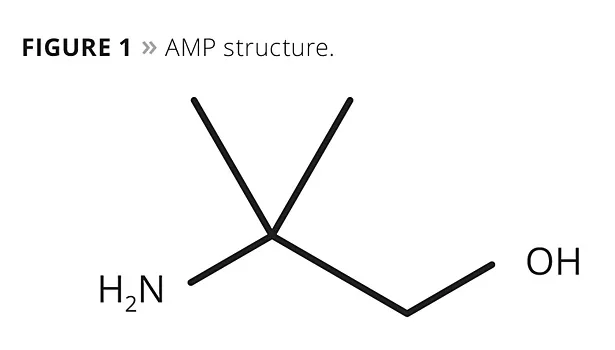The Journey to VOC Exemption
AMP becomes the only organic amine to gain the EPA’s VOC-exemption status

Credit: ANGUS Chemical
In a decision with positive consequences for the coatings industry, the U.S. EPA recently ruled that the multifunctional paint additive 2-amino-2-methyl-1-propanol (AMP; CAS=124-68-5) would no longer be regulated as a volatile organic compound (VOC). The EPA promptly revised its regulatory definition of VOCs under the Clean Air Act to remove AMP on the basis that this compound makes a negligible contribution to tropospheric (ground-level) ozone formation.
EPA defines a VOC as “any compound of carbon, excluding carbon monoxide, carbon dioxide, carbonic acid, metallic carbides or carbonates, and ammonium carbonate, which participates in atmospheric photochemical reactions,” with the exception of chemicals that EPA has determined to have “negligible photochemical reactivity,” such as 2-amino-2-methyl-1-propanol. So, essentially any organic compound that has not been exempted by EPA is considered to be a VOC.
“AMP’s performance as a multifunctional neutralizer, combined with its reduced ozone potential and favorable toxicity data, makes this product a preferred one compared to more toxic chemicals used for the same purpose,” the EPA wrote in its direct final rule, referring to low potential for ground-level ozone formation.
With the EPA’s decision, AMP became the only organic amine to gain VOC-exempt status. The business implications of this are significant for paint manufacturers, who face consumer and regulatory pressure to develop high-performing, low- or no-VOC paints.
AMP is a primary amino alcohol with unique properties that are valuable for pigment dispersion, scrub resistance and neutralization for many different applications. The compound is already used as a key ingredient in many waterborne paints. With its new VOC-exempt status, paint companies can use the additive with peace of mind knowing that they are not increasing the VOC levels of their products.
The regulatory ruling also means that paint manufacturers can avoid reformulating with less-favorable neutralizers such as caustic soda or ammonia - which are not EPA regulated since they are not carbon compounds - that come with unpleasant side effects. Caustic soda, for example, is hazardous to handle and offers poor pH control, while ammonia is considered environmentally hazardous and toxic, has an unpleasant smell, and can reduce early water resistance.
As paint companies know very well, environmentally conscious consumers are increasingly demanding no- and low-VOC paints, which puts formulators under pressure to use ingredients that will help them achieve effective and eco-friendly products. Various state regulatory bodies and industry standards also come into play, tightening the standards for the level of VOC content allowed in each can of paint.
With these market realities in mind, ANGUS prepared and submitted a petition to EPA to exempt AMP from the VOC definition in the U.S. Clean Air Act. This petition was supported by results from an independent testing laboratory regarding potential for ozone formation, data concerning potential for stratospheric ozone depletion, and potential for global warming/climate change impacts, as well as toxicology data showing a favorable mammalian and environmental toxicity profile.
A Closer Look at AMP
AMP has a molecular weight of 89, boiling point of 165 ºC and vapor pressure of 0.34 mm Hg @ 20 ºC. The pure chemical is a gel-like crystalline solid, which is miscible in water (Figure 1).
AMP is preferred in many latex paints due to its versatile and multifunctional nature. Whereas many additives only improve one performance factor of a coating, AMP offers many improvements, including dispersion, alkalinity control, film integrity and low odor. Its multifunctionality allows for lower levels of other additives such as anionic dispersants, defoamers and wet-edge agents; this can result in performance improvements, and in some cases, cost savings for formulators by way of a decrease in dosages.
AMP has been used globally to help solve multiple formulation challenges for both latex and alkyd coatings, as well as a host of other applications including metalworking fluids and personal care products. But while AMP has long been considered a powerful, multifunctional additive, manufacturers in the past have treated the molecule as a VOC because it has been classified as such in the United States. These factors began to limit the use of AMP in premium paints.
In light of increasing consumer and regulatory demand for environmentally sustainable paints, ANGUS saw the business need to review the classification of AMP under the Clean Air Act.
Why Does EPA Regulate VOC?
The two types of chemicals that are the main ingredients in forming ground-level ozone are VOCs and nitrogen oxides. VOCs are released by many sources, including petroleum refineries, chemical manufacturing plants and vehicles that burn gasoline. The solvents used in paints and other consumer and business products often contain VOCs. Nitrogen oxides are produced when cars and other sources like power plants and industrial boilers burn fossil fuels such as gasoline, coal or oil. When VOCs and nitrogen oxides react in the atmosphere in the presence of sunlight, ozone forms. This takes time - several hours from the time pollutants get into the air until the ground-level ozone reaches unhealthy levels. The weather conditions and topography of the land can impact where the ground-level ozone forms and how much is formed; high concentrations of ground-level ozone can remain for days at a time in some conditions.
Ground-level ozone is a primary component of smog, which also contains soot particles and industrial fumes. Ground-level ozone can cause human health problems and damage the natural environment as well as agricultural crops. Repeated exposure to ozone can make people more susceptible to respiratory problems and can aggravate pre-existing respiratory diseases, such as asthma. Children and outdoor workers are especially susceptible to ozone pollution because they are often outside, working or playing, particularly during the summer days when ozone levels are at their highest. People with asthma -and even active, healthy adults -can experience a reduction in lung function and an increase in respiratory symptoms such as chest pain and coughing when exposed to low levels of ozone during periods of moderate exertion. Because of the harmful health effects of ozone, the EPA and state governments limit the amount of VOCs that can be released into the atmosphere.
The Clean Air Act requires the EPA to establish national ambient air quality standards for certain common and widespread atmospheric pollutants based on the latest science, and one of those pollutants is ozone. EPA has set air quality standards for six common “criteria pollutants,” which are: particulate matter (also known as particle pollution), ozone, sulfur dioxide, nitrogen dioxide, carbon monoxide and lead. The Clean Air Act and the industry’s air quality standards have resulted in changes in product formulas to reduce the VOC content of many products. This has resulted in lower smog and cleaner air in U.S. cities.
EPA’s Regulatory Definition of VOC
An excerpt from the Clean Air Act, VOC definition 40 CFR 51.100(s,) can be found at www.ecfr.gov/cgi-bin/text-idx?rgn=div8&node=40:2.0.1.1.2.3.8.1 under part (s).
The Path to VOC Exemption Begins With MIR
MIR is an abbreviation for Maximum Incremental Reactivity. One of the most important factors in the EPA’s classification of a compound as a VOC under the Clean Air Act is whether it will participate in the formation of ground-level ozone. The impact on ground-level ozone is currently quantified by MIR, which measures the increase in ozone formation when a material such as AMP is added to a well-defined atmosphere in a specifically designed chamber. The MIR value is a measure of photochemical reactivity, either measured directly or derived from a computer-based photochemical model that considers the complete ozone forming activity of a compound.
The EPA uses the reactivity of ethane as the threshold for determining whether a compound has negligible reactivity. Compounds that are less reactive than, or equally reactive to, ethane under certain assumed conditions may be deemed negligibly reactive and, therefore, suitable for exemption from the VOC definition. Compounds that are more reactive than ethane continue to be considered VOCs for regulatory purposes and therefore subject to control requirements. The selection of ethane as the threshold compound was based on a series of smog chamber experiments that is the basis for the EPA’s policy.
With a contract from the California Air Resources Board (CARB), an independent lab, run by Dr. William P. L. Carter at the University of California, Riverside, tested AMP to determine its level of overall atmospheric reactivity. Dr. Carter studied AMP in an experimental smog chamber; the chemical mechanism derived from the study was used to model the complete formation of ozone for an entire single day under realistic atmospheric conditions. Results showed that the MIR value for AMP is 0.25 grams ozone per gram of VOC, below the MIR value of the benchmark chemical ethane, which is 0.28 gram ozone per gram of VOC.
Based on the lower MIR value for AMP, as well as its favorable toxicity profile and lower global warming potential, ANGUS requested that the EPA revise its definition of VOCs for purposes of preparing State Implementation Plans to attain the national ambient air quality standard for ozone under Title I of the Clean Air Act. This proposed revision would add AMP to the list of compounds excluded from the definition of VOC on the basis that this compound makes a negligible contribution to tropospheric ozone formation.
A Speedy Review by EPA
It has been the EPA’s policy that organic compounds with a negligible level of reactivity should be excluded from the regulatory VOC definition so as to focus VOC control efforts on compounds that do significantly increase ozone concentrations. In October 2012 ANGUS submitted a petition to the EPA to exempt AMP from regulation as a VOC. The petition included the independent MIR testing data provided by Dr. Carter, and noted that AMP meets the criteria that have been used to grant prior VOC petitions. The company stressed the urgency of the situation:
“Manufacturers and formulators of water-based coatings need access to AMP to meet VOC limits on their products without impairing performance of their products,” the petition stated. “The VOC exemption for AMP, in line with its lower MIR value compared to ethane, will allow AMP to continue to be a preferred additive. Prompt action is needed so that companies do not incur the cost of changing formulations in ways that will not achieve any real benefit.”
After an 18-month review and a 60-day comment period, the EPA issued its final rule, effective June 25, 2014, identifying AMP as a chemical compound that will no longer be regulated as a VOC under the Clean Air Act [40 CFR 51.100(s)].
Conclusion
With the VOC exemption under the federal Clean Air Act now granted, ANGUS expects that formulators in the United States will continue to use AMP as one of the most effective products in next-generation coatings with an improved environmental profile. In addition, ANGUS expects to see AMP’s continued use as a preferred multifunctional neutralizer in other markets, including metalworking fluids and personal care applications. n
For more information, visit www.angus.com.
By Linda Troester, EH&S Product Stewardship Manager; and Patrick Brutto, Global TS&D Leader, ANGUS Chemical, Buffalo Grove, IL, and Asghar Peera, Research Scientist, Dow Chemical Company, Collegeville, PA
Looking for a reprint of this article?
From high-res PDFs to custom plaques, order your copy today!






